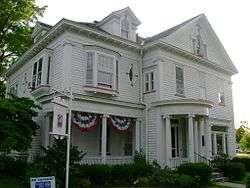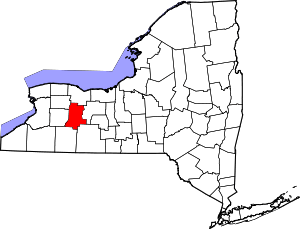Dansville, Livingston County, New York
Dansville is a village in the town of North Dansville, with a small northern part in the town of Sparta in Livingston County, in western New York, United States. As of the 2010 census, the village population was 4,719.[3] The village is named after Daniel Faulkner, an early European-American settler.[4] Interstate 390 passes the west side of the village.
Dansville, New York | |
|---|---|
Village | |
 Dansville  Dansville | |
| Coordinates: 42°33′43″N 77°41′46″W | |
| Country | United States |
| State | New York |
| County | Livingston |
| Town | North Dansville |
| Area | |
| • Total | 2.61 sq mi (6.75 km2) |
| • Land | 2.61 sq mi (6.75 km2) |
| • Water | 0.00 sq mi (0.00 km2) |
| Elevation | 705 ft (215 m) |
| Population (2010) | |
| • Total | 4,719 |
| • Estimate (2019)[2] | 4,373 |
| • Density | 1,676.76/sq mi (647.47/km2) |
| Time zone | UTC-5 (Eastern (EST)) |
| • Summer (DST) | UTC-4 (EDT) |
| ZIP code | 14437 |
| Area code(s) | 585 |
| FIPS code | 36-19664 |
| GNIS feature ID | 0948024 |
| Website | www |
History
Daniel Faulkner founded the village in 1795. This was land ceded by the Iroquois tribes to the United States after the Revolutionary War, as four of the tribes had been allies of the defeated British forces. When Livingston County was created, the village was included in the town of Sparta. Dansville became an incorporated village in 1845.
A spa, which opened in 1854, attracted many prominent people for the water cure. Located in the "Castle on the Hill", the spa operated for many years under several owners.[5]
The Delaware, Lackawanna & Western Railroad opened its mainline between Binghamton and Buffalo on a route high above Dansville, on September 17, 1882. The "Dansville Hill" was an impediment to heavy eastbound trains for 81 years, until the mainline was abandoned by the Erie Lackawanna Railroad between Groveland and Wayland in late 1963. A portion of the right-of-way is now used as an access road to a cellphone tower, which has views looking westward down to Dansville and its surrounding area.
The Dansville Downtown Historic District, Dansville Library, Engleside, English Evangelical Lutheran Church, Elias H. Geiger House, William Hartman Farmstead, Pioneer Farm, and post office are all significant areas and structures listed on the National Register of Historic Places.[6][7]
Notable people
- Harriet N. Austin, physician and dress reform advocate; grew up in Dansville
- Clara Barton visited Dansville in 1866 to deliver a lecture about her service during the Civil War. She visited again in 1873, during which time she stayed at the Home on the Hillside to recuperate from the toil of nursing soldiers in the Franco-Prussian War. Between 1876 and 1886, she maintained a residence in Dansville. From here she ran the effort to form the American Red Cross, to achieve government recognition, and join the Geneva Convention, which would make it a part of the International Red Cross. Thus, the first American Red Cross chapter was established in the village[8] in 1881.[9] It is still located at 57 Elizabeth Street.[8]
- Edward T. Fairchild, Wisconsin jurist; raised in Dansville[10]
- Millard Fillmore, 13th president of the United States; resided in the village for several months[11]
- Job E. Hedges, Republican nominee for governor of New York in 1912[12]
- Robert F. Hart, president of Dansville and Mount Morris Railroad; elected North Dansville Town Supervisor in 1955, and became the longest-serving town supervisor in Livingston County
- Dennis Walter Hickey, Auxiliary Bishop of Rochester, New York
- James Caleb Jackson, created Granula, the world's first breakfast cereal
- Andrew J. Lorish, Union Army soldier and Medal of Honor winner; born in Dansville in 1832
- Francis Marion Perine, M.D. doctor, vigneron, civic leader.
- Nathaniel Rochester, founder of Rochester, New York. His Dansville home was moved to the Genesee Country Village and Museum Pioneer Village. In Dansville, Col. Rochester purchased from David Scholl a plank house, believed to have been built around 1797. Once settled in Dansville, where he had purchased most of the water rights on Canaseraga Creek, Col. Rochester erected a large paper mill and a gristmill.
- John Sullivan, Major League Baseball catcher and coach
Geography
According to the United States Census Bureau, the village has a total area of 2.6 square miles (6.8 km2), all of it recorded as land.[13] The village sits in a glacially formed valley, common throughout western New York. Canaseraga Creek flows northward just west of the village limits; it is a tributary of the Genesee River.
Interstate 390, New York State Route 36, New York State Route 63, New York State Route 256, and New York State Route 436 pass through the village. It is bordered to the northwest by the unincorporated community of Cumminsville. Geneseo, the Livingston county seat, is 18 miles (29 km) to the northwest, Hornell is 17 miles (27 km) to the south, Corning is 51 miles (82 km) to the southeast, and Rochester is 44 to 53 miles (71 to 85 km) to the north, depending on which highway one takes. Stony Brook State Park, with waterfalls, hiking, and swimming, is 3 miles (5 km) south of the village.
Demographics
| Historical population | |||
|---|---|---|---|
| Census | Pop. | %± | |
| 1870 | 3,387 | — | |
| 1880 | 3,625 | 7.0% | |
| 1890 | 3,758 | 3.7% | |
| 1900 | 3,633 | −3.3% | |
| 1910 | 3,938 | 8.4% | |
| 1920 | 4,631 | 17.6% | |
| 1930 | 4,928 | 6.4% | |
| 1940 | 4,976 | 1.0% | |
| 1950 | 5,253 | 5.6% | |
| 1960 | 5,460 | 3.9% | |
| 1970 | 5,436 | −0.4% | |
| 1980 | 4,979 | −8.4% | |
| 1990 | 5,002 | 0.5% | |
| 2000 | 4,832 | −3.4% | |
| 2010 | 4,719 | −2.3% | |
| Est. 2019 | 4,373 | [2] | −7.3% |
| U.S. Decennial Census[14] | |||
As of the census[15] of 2000, there were 4,832 people, 1,976 households, and 1,246 families residing in the village. The population density was 2,042.4 people per square mile (787.2/km²). There were 2,090 housing units at an average density of 883.4 per square mile (340.5/km²). The racial makeup of the village was 95.78% White, 1.26% African American, 0.23% Native American, 0.66% Asian, 1.30% from other races, and 0.77% from two or more races. Hispanic or Latino of any race were 2.07% of the population.
There were 1,912 households out of which 34.0% had children under the age of 18 living with them, 46.7% were married couples living together, 14.2% had a female householder with no husband present, and 34.8% were non-families. 28.6% of all households were made up of individuals and 14.0% had someone living alone who was 65 years of age or older. The average household size was 2.49 and the average family size was 3.03.
In the village, the population was spread out with 26.7% under the age of 18, 8.7% from 18 to 24, 27.5% from 25 to 44, 21.3% from 45 to 64, and 15.7% who were 65 years of age or older. The median age was 37 years. For every 100 females, there were 90.1 males. For every 100 females age 18 and over, there were 86.2 males.
The median income for a household in the village was $32,903, and the median income for a family was $41,519. Males had a median income of $31,699 versus $25,256 for females. The per capita income for the village was $15,994. About 12.3% of families and 17.0% of the population were below the poverty line, including 17.3% of those under age 18 and 11.7% of those age 65 or over.
Infrastructure

Dansville Municipal Airport (DSV) is a general aviation airport located north of the village. The airport was opened in 1927, primarily by the efforts of World War I aviator Lynn Pickard. The New York State Festival of Balloons is held at the airport in early September.
A branch of Genesee Community College is located in Dansville.
Nicholas H. Noyes Memorial Hospital, a 72-bed acute care hospital, is located on the southern edge of the village on Route 36 adjacent to Exit 4 on Interstate 390. It provides health services to residents of Livingston, Allegany, Steuben and surrounding counties.
_(14756370861).jpg)
Culture
Castle on the Hill is a former water cure facility that resembles a castle overlooking Dansville from the hillside. Founded in 1858 by Dr. James Caleb Jackson as the "Our Home on the Hillside",[16] the original building burned in 1882. The present building opened in 1883. It has changed hands several times, becoming a physical fitness hotel (the Physical Culture Hotel) where the rich and famous came from New York City and other areas to "get away from it all". The building now stands vacant.
A grant from New York State for $2.5 million was approved in January 2008 to renovate the former "Jackson Health Resort".
References
- "2019 U.S. Gazetteer Files". United States Census Bureau. Retrieved July 27, 2020.
- "Population and Housing Unit Estimates". United States Census Bureau. May 24, 2020. Retrieved May 27, 2020.
- "Total Population: 2010 Census DEC Summary File 1 (P1), Dansville village, New York". data.census.gov. U.S. Census Bureau. Retrieved June 10, 2020.
- Chisholm, Hugh, ed. (1911). . Encyclopædia Britannica. 7 (11th ed.). Cambridge University Press. p. 810.
- Cayleff, Susan E. (1991). Wash and Be Healed: The Water-Cure Movement and Women's Health. Philadelphia: Temple University Press. p. 94. ISBN 0-87722-859-0.
- "National Register Information System". National Register of Historic Places. National Park Service. March 13, 2009.
- "National Register of Historic Places Listings". Weekly List of Actions Taken on Properties: 6/24/13 through 6/28/13. National Park Service. 2013-07-05.
- Marks, Mary Jo. "Clara Barton in Dansville, 1866 and 1876-1886". Dansville Historical Society. Retrieved 1 July 2009.
- ""Cultural Resource Information System (CRIS)"". New York State Office of Parks, Recreation and Historic Preservation. Archived from the original (Searchable database) on 2015-07-01. Retrieved 2015-11-01. Note: This includes Virginia L. Bartos (March 2013). "National Register of Historic Places Registration Form: English Evangelical Lutheran Church of Dansville" (PDF). Retrieved 2015-11-01. and Accompanying photographs
- "The Blue Book of Wisconsin (1907)," pp. 1126-1127
- "Dansville History". Dansville Public Library. 2016-12-08. Retrieved 2018-02-01.
- Nevin, Andrew Parker (1925). "Memorial of Job E. Hedges". Yearbook of the New York County Lawyers' Association. New York, NY: J. J. Little & Ives: 213.
- "U.S. Gazetteer Files: 2019: Places: New York". U.S. Census Bureau Geography Division. Retrieved June 10, 2020.
- "Census of Population and Housing". Census.gov. Retrieved June 4, 2015.
- "U.S. Census website". United States Census Bureau. Retrieved 2008-01-31.
- Cayleff, Susan E. (1991), p.114
External links
| Wikisource has the text of the 1911 Encyclopædia Britannica article Dansville. |
- Village of Dansville official website
- Dansville Public Library
- New York State Festival of Balloons
- "The Castle on the Hill": history, present-day photos, and video of the Jackson Sanatorium
- History of the Castle on the Hill
- Physical Culture Hotel brochure
